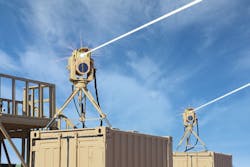Navy taps MZA Associates to develop portable laser weapons for counter-UAV operations on land and sea
ARLINGTON, Va. – Laser weapons experts at MZA Associates Corp. in Albuquerque, N.M., are adding their expertise to U.S. military efforts to develop portable high-energy lasers to damage or destroy unmanned aerial vehicles (UAVs) that are violating the airspace of military bases or other sensitive installations.
Officials of the U.S. Office of Naval Research (ONR) in Arlington, Va., announced an $18.7 million contract Wednesday to MZA Associates to develop the counter unmanned aerial vehicle (C-UAS) High Energy Laser Weapon System (HELWS).
MZA engineers will design, develop, deliver, integrate, test, and demonstrate a compact, portable, low-cost and reliable C-UAS HELWS using the latest available commercial components.
Such a system potentially could enable U.S. Marines on the ground or sailors aboard surface warships to destroy, disable, or discourage potentially hostile UAVs flying too closely to Marine ground units, ships, or forward-deployed bases.
MZA Associates specializes in modeling, analysis, design, development, integration, and testing of high-energy laser and advanced optical systems in support of advanced beam-control systems, atmospheric characterization, and optical systems engineering.
MZA provides expertise in wave-optics modeling; adaptive optics; and scientific data acquisition, analysis, and management. The company developed the WaveTrain wave-optics analysis tool for the analysis of optical atmospheric propagation and adaptive optics systems.
MZA joins the Raytheon Technologies Corp. Intelligence & Space segment in McKinney, Texas, in efforts to develop portable and mobile laser weapons for anti-UAV warfare.
Raytheon is providing the U.S. Air Force Research Laboratory at Wright-Patterson Air Force Base, Ohio, with counter-UAV high-energy laser weapons for counter-drone operations. The company won a $13.1 million order in late 2019 to build a HELWS for six months of in-field evaluation against enemy UAVs.
Related: Laser weapons get ready for the big time
The Raytheon prototype HELWS combines a solid-state laser weapon with a Raytheon multi-spectral targeting system. The unit mounts to a military RZR all-terrain vehicle from Polaris Inc. in Medina, Minn. This results in an advanced, lightweight, and adaptable weapons system that enables military mobile light forces to defend against enemy UAVs in a wide variety of conditions and terrain.
The Office of Naval Research is supporting development of directed-energy weapons that cause physical damage that degrades, neutralizes, defeats, or destroys enemy capabilities such as UAVs.
ONR is supporting research potentially leading to naval laser subsystems, beam directors, and fire-control architectures, including advanced design power architectures for low-duty cycle and continuous-wave laser applications with reduced size, weight, and power consumption, and cooling (SWAP-C).
ONR researchers particularly are interested in laser components that offer high brightness, high power-beam-combining technologies, and controlled micro-channel optical component cooling methods that reduce thermal distortions for enhanced beam quality.
Related: The new era of high-power electromagnetic weapons
ONR also is sponsoring research in directed-energy weapons system tracking sensors, target illuminator,s and automated target recognition components -- especially those that offer tracking through intermittent or partially obscured maritime viewing conditions.
On this contract MZA Associates will do the work in Albuquerque, N.M., and Dayton, Ohio, and should be finished by August 2023. With options, the project could continue through August 2025.
For more information contact MZA Associates online at www.mza.com, or the Office of Naval Research at www.onr.navy.mil.
About the Author
John Keller
Editor-in-Chief
John Keller is the Editor-in-Chief, Military & Aerospace Electronics Magazine--provides extensive coverage and analysis of enabling electronics and optoelectronic technologies in military, space and commercial aviation applications. John has been a member of the Military & Aerospace Electronics staff since 1989 and chief editor since 1995.
